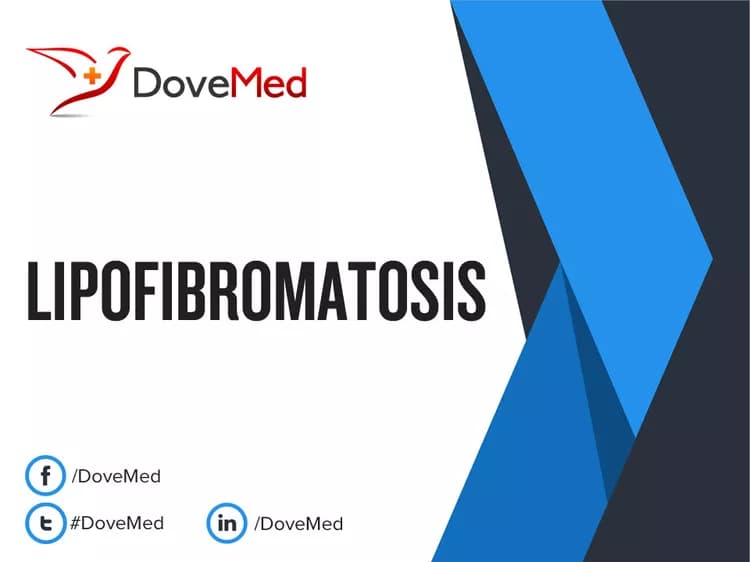What are the other Names for this Condition? (Also known as/Synonyms)
- Infantile Fibromatosis Variant (Non-Desmoid Type)
- Juvenile Fibromatosis Variant (Non-Desmoid Type)
What is Lipofibromatosis? (Definition/Background Information)
- Lipofibromatosis is a highly infrequent benign tumor of fatty tissues typically seen in children. Some of these tumors are known to have a congenital presentation
- The cause and risk factors for Lipofibromatosis have not been established. Some studies indicate that it may be due to genetic factors
- The tumors are slow-growing and present with no pain. The most frequent sites are the hands and feet, in over 50% of the cases
- The treatment of choice is a complete surgical removal through simple excision. The prognosis of Lipofibromatosis is excellent with suitable treatment, although there is a high risk for recurrence of the tumor
Who gets Lipofibromatosis? (Age and Sex Distribution)
- Lipofibromatosis is a very rare tumor that is almost always seen in children; 1 in 5 may also be congenital in nature (present at birth)
- Newborn babies, infants, and children up to age 14 years may be affected
- The male-female ratio is 2:1, implying that boys are affected twice more than girls
- There is no predilection to any ethnic group or a particular race; these pediatric tumors are observed worldwide
What are the Risk Factors for Lipofibromatosis? (Predisposing Factors)
- The risk factors for Lipofibromatosis development are currently unknown
- Some cases are associated with macrodactyly (large fingers or toes)
It is important to note that having a risk factor does not mean that one will get the condition. A risk factor increases ones chances of getting a condition compared to an individual without the risk factors. Some risk factors are more important than others.
Also, not having a risk factor does not mean that an individual will not get the condition. It is always important to discuss the effect of risk factors with your healthcare provider.
What are the Causes of Lipofibromatosis? (Etiology)
- The exact cause of Lipofibromatosis formation is unknown
- Some studies indicate that they may arise due to genetic factors, which have not been currently well-characterized
What are the Signs and Symptoms of Lipofibromatosis?
The signs and symptoms of Lipofibromatosis may include:
- They may be present as a slow-growing irregularly-shaped mass; sometimes, these may resemble fluid-filled lymph nodes (visible on radiological studies)
- Lipofibromatosis tumors may occur subcutaneously or buried deep in the tissues
- Pain is generally not observed due to these tumors
- The tumor may range in size from 1-5 cm; some tumors may be larger
- Most common locations of the tumors are the hands and feet (over half of them are seen at these sites); some rare cases are known to involve the entire hand or feet
- 1 in 6 tumors are located in the head and neck region or the back and chest (trunk)
- Presence of large fingers or large toes (macrodactyly)
How is Lipofibromatosis Diagnosed?
A diagnosis of Lipofibromatosis is made using the following tools:
- Complete physical examination with a thorough evaluation of medical history
- Imaging studies of the affected region via a CT or MRI scan
- A tissue biopsy of the tumor: A tissue biopsy is performed and sent to a laboratory for a pathological examination. A pathologist examines the biopsy under a microscope. After putting together the clinical findings, special studies on tissues (if needed) and with microscope findings, the pathologist arrives at a definitive diagnosis. Examination of the biopsy under a microscope by a pathologist is considered to be the gold standard, in arriving at a conclusive diagnosis
Many clinical conditions may have similar signs and symptoms. Your healthcare provider may perform additional tests to rule out other clinical conditions to arrive at a definitive diagnosis.
What are the possible Complications of Lipofibromatosis?
The complications from Lipofibromatosis could include:
- Recurrence after incomplete surgical removal; studies reveal a high recurrence rate for Lipofibromatosis tumors
- Some individuals may feel emotionally stressed due to the presence of these tumors, or due to the cosmetic issues they create
How is Lipofibromatosis Treated?
Treatment measures for Lipofibromatosis include the following:
- The healthcare provider may recommend a ‘wait and watch’ method for small-sized tumors that present no significant symptoms
- A simple surgical excision with removal of the entire lesion is the preferred treatment method. If the tumor is not fully removed, then it can recur
- Follow-up care with regular screening and check-ups are important
How can Lipofibromatosis be Prevented?
Current medical research has not established a way of preventing Lipofibromatosis occurrence.
What is the Prognosis of Lipofibromatosis? (Outcomes/Resolutions)
- The prognosis of Lipofibromatosis is excellent on their complete surgical removal. These tumors are non-malignant and no metastasis is observed
- The probability of Lipofibromatosis recurrence is high following their surgical removal. Hence, regular follow-up with periodic medical screening is to be ensured
- The pointers for tumor recurrence may include:
- Tumors in boy babies that is seen at birth
- Tumors of the hand or foot
- A partial surgical removal of the tumor
Additional and Relevant Useful Information for Lipofibromatosis:
Please visit our Cancer & Benign Tumor Health Center for more physician-approved health information:
Related Articles
Test Your Knowledge
Asked by users
Related Centers
Related Specialties
Related Physicians
Related Procedures
Related Resources
Join DoveHubs
and connect with fellow professionals


0 Comments
Please log in to post a comment.